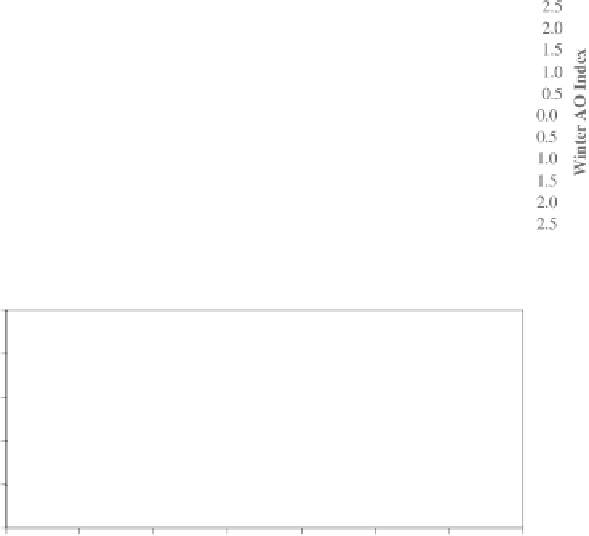Geoscience Reference
In-Depth Information
Figure 11.
(top) Time series of simulated Northern Hemisphere September sea ice extent in 10
6
km
2
and the AO index
averaged over winter months (NDJFmA). Note the reversed scale for the AO index. (bottom) The same sea ice time
series compared with the North Atlantic Ocean heat flux. This is given as the sum of heat fluxes through the Davis and
Fram straits, between Svalbard and Franz Josef land, and between Franz Josef and Nova Zemlya. Note the reversed scale
for the heat flux in PW.
might exist for such events over the past millennium. Such
evidence is difficult to obtain. The HadISST1 data set ex-
tends prior to the satellite era to 1900, which corresponds to
the beginning of Russian historical records of sea ice extent
[
Polyakov et al.
, 2003].
Lemke et al.
[2007] review these
available data sources. Prior to the 20th century, a limited
number of proxy information are available. Recent sedimen-
tary coring of the Lomonosov Ridge has provided evidence
for the onset of a perennial Arctic sea ice cover at about 13
Ma [
Krylov et al.
, 2008]. Variations in this cover have been
examined in more recent records. Using ice cores, ocean
cores, and mammalian and archeological histories,
Fisher
et al.
[2006] notes the evidence for a minimum ice cover
occurring in the early Holocene at 10,500-9000 years be-
fore present. Proxy characterizations of ice cover are not as
quantitative as satellite observations; however, the evidence
indicates that Davis Strait and Bering Sea bowhead whales
were able to intermingle during this time. The most readily
accessible proxy information is from transported driftwood,
which circulates within the Arctic in the presence of an ice
cover [e.g.,
Dyke et al.
, 1997;
Bennike
, 2004;
Johansen
,
2001;
Tremblay et al.
, 1997]. Studies by
Dyke et al.
[1997]
suggest a change in driftwood patterns occurring 4000 years
before present. The studies of Dyke et al. and Tremblay et
al. emphasize the patterns of drift in the Arctic, and suggest
an enhanced Beaufort Gyre over the last 4000 years, and
a more variable gyre pattern earlier in the record. As this
study has indicated, the strength of the Beaufort Gyre has
important consequences for Arctic ice extent. These records
have a temporal resolution of about 10 years and thus would
not be capable of recording episodic, single-year anomalies
of the kind examined in this study. moreover, it is important
to expressly distinguish “natural” variability from the inter-
nal variability using 1990 anthropogenic forcings, which are
clearly not preindustrial. As part of this study, an extended
1860 control simulation of the Geophysical Fluid Dynamics
laboratory (GFDl) of NOAA cm2 [
Delworth et al.
, 2006]
was examined and found to contain a single ice anomaly
event over a comparable simulation period to the time exam-
ined here. The GFDl model has significantly different sea
ice characteristics than those of the CCSM3. Nevertheless,
it is likely proper to view the time series of extended control











Search WWH ::

Custom Search